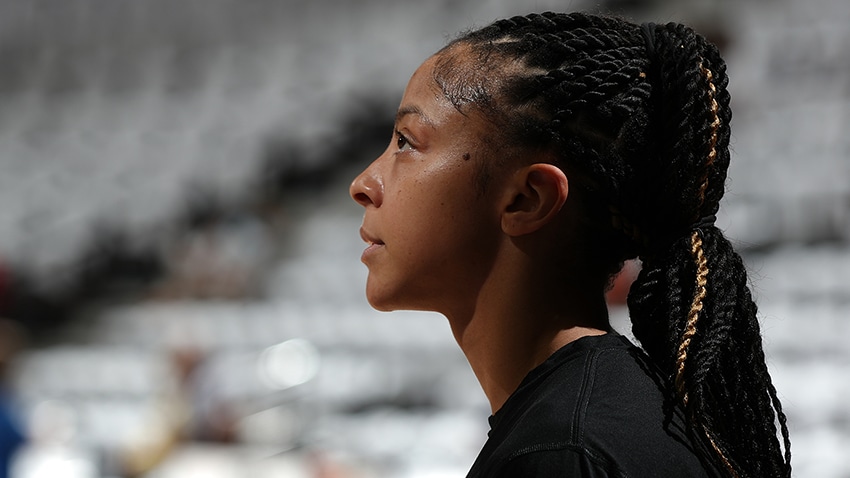Fantasy WNBA: How to Play Fantasy Women’s Basketball

Welcome to an exciting new era! We are pumped for the upcoming WNBA season, and our brand new fantasy women’s basketball game. Our standard game setting will be familiar to those who play head-to-head points NBA fantasy basketball, but adapted to the 12-team WNBA league and its shorter season. League Managers will be able to customize many of these settings, including league and roster size as well as the scoring system, but let’s dive into how the standard settings for Fantasy WNBA:
Point = 1 Fantasy Point (FP)
Rebound = 1 FP
Assist = 1 FP
Made 3-pointer = 1 FP
Steal = 2 FP
Block = 2 FP
Points, rebounds and steals are all potentially high-volume categories, so they earn one fantasy point each. Steals and blocks are harder to come by, so they are worth twice as much. Making a 3-pointer gets the extra point to reward the more difficult shot. This allows you to build your fantasy rosters with different, unique player types that contribute in different ways.
For example, Sylvia Fowles was the only player in the league to finish top-5 in both blocks and steals last season. Her 16.0 points, 10.1 rebounds, 1.4 assists, 1.8 blocks, 1.8 steals and 0.0 3-pointers per game were worth 16+10.1+1.4+3.6+3.6+0 = 34.7 fantasy points per game.
Meanwhile, Arike Ogunbowale was the only player in the top-5 in both scoring and 3-pointers made. Her 18.7 PPG, 3.2 RPG, 3.3 APG, 1.2 SPG, 0.0 BPG and 2.5 3PG were worth 18.7+3.2+3.3+2.4+0.0+5.0 = 32.6 FP/G.
And GOAT candidate Sue Bird (have you seen her commercial?) checked in as the only player in the top-5 in both assists and 3-pointers made… in her age 40 season! Her 10.0 PPG, 2.6 RPG, 5.3 APG, 0.9 SPG, 0.1 BPG and 2.2 3PG were worth 24.3 FP/G.
At the end of the day, WNBA stars will be among the elite fantasy scorers, regardless of their production style. There is also room for lower-volume players to shine, if they contribute significantly in the more difficult to garner categories. This includes the glue players that control the paint, defensive anchors and long-range shooters.
The Basics – What you need to know
The WNBA season is 32 games, and runs from May 6 to August 14. Teams will typically play 2-3 games per week, yielding plenty of exhilarating action during the summer months.
There are 12 teams in the league, as opposed to the 30 in the NBA, so the fantasy roster sizes are a bit smaller. A typical league will be six fantasy teams with nine roster spots each, thus a nine-round fantasy draft.
You’ll start six players: two guards, three forwards/centers and one utility spot that can be any position.
Each week, every fantasy team goes head-to-head against one other team, and the one that accumulates the most fantasy points gets a win while the other team gets a loss. The teams with the best win-loss records advance to the fantasy playoffs and face one another to determine a champion. You can also select the optional “bonus scoring” feature and compete for a second weekly win, given to the top-scoring half of the league’s teams. So while it is possible to win your matchup while scoring the second-least points, or lose while scoring the second-most, bonus scoring always rewards the highest scorers of the week.
The Draft – How to pick your team
The most important — and for many, the most fun — part of putting together a fantasy team is the draft. Snake drafts and Salary Cap drafts are the most popular of the four methods available, but choose the one that works best for you:
Snake: Players are chosen in a set order in the first round and then the draft order is reversed for each round thereafter. (Example: 1, 2, 3, 4, 5, 6 then 6, 5, 4, 3, 2, 1).
Salary Cap: Team managers use a fictional budget to nominate and sign players until their roster is filled. Suggested values are listed in the draft room, with $1 being the minimum.
Autopick: The system automatically drafts players to each team in the league on a scheduled draft date so team managers don’t have to be online during the draft.
Offline: Team managers conduct their own draft without the use of ESPN’s online draft system, then manually input the offline draft results into the system.
The Game plan – How to win your league
Being a successful team manager means taking an active role in running your team throughout the WNBA season.
At a minimum, that means:
1) making adjustments to your starting lineup from the start of the season until the end
2) adding free agents who can help your team and cutting players who are ineffective
3) moving injured players to the Injured Reserve to open up an available roster spot that can be filled
Keep an eye on this space for plenty of analysis to help you build a championship roster and enjoy the WNBA season in an entirely new way.
Original article posted on ESPN. Andre Snellings has worked as both a writer and on-air talent for ESPN since 2017 covering a wide range of sports, but specializing in women’s basketball.




